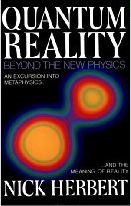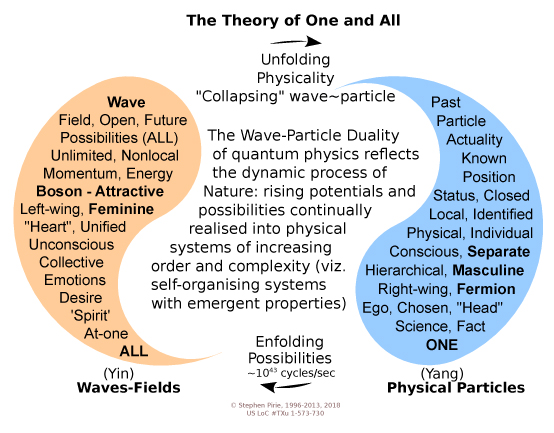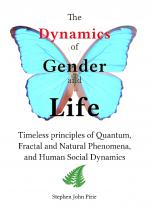Nick Herbert's "Quantum Reality: Beyond the New Physics" is regarded on Amazon as "a classic" and "a must read, a must re-read" book on the subject.

One paragraph in the book explaining the behaviour of an electron was for me a catalyst for an important ah-hah experience:
Herbert was explaining how matter and energy behaves as both waves and particles (in a complementary manner, at the same time).
In a flash it all made sense: Men are particles, women are waves, roughly speaking. Men tend towards the individual particle nature: the hard-shelled ego strongly identified, the masculine tendency towards retaining their competitive identities in "collisions" (sports, wars) and towards the extremes of behaviour (hence the preponderance of male murderers and musicians).
Women on the other hand tend towards the collective-wave nature of "merging" with communities (focused on family, relationships, feelings, communication, nurturing the group by not being extreme or disruptive etc.).
And as within the quantum world – where 'things' are both waves and particles (inherently, depending on how they are observed) – so within everyday life, where men can be 'wave-natured' ( feminine, caring, community focused), or 'particle-natured' (masculine, warrior focused, 'commitment phobic', selfish, competitive); women can be 'particle-natured' (masculine, competitive, objective, selfish) or 'wave-natured' (feminine, caring, sharing, selfless) and so on.
At various times since that initial ah-hah moment, I've experienced avalanches of ideas and associations, with one occasion in particular requiring me to pull over while driving so that I could write down the flood of correlations.
However like any scientist (but not as one), I'm always keen to put the Theory of One and All1 to the test, even though I intuitively feel its universal validity.
Sexing the small bits
With the benefit of the TOA, we can make sense of the behaviour of the elementary particles comprising the atoms and chemicals in our brains and bodies.
It's how the components join, or don't, that gives rise to the noticeable differences in characteristics of particles, atoms, animals, people and planets.
Recently I started to look again at the field of quantum theory, and wondered how the fundamental building blocks of atoms (quarks, leptons and the like) would fit the TOA (Theory of One and All).
Once again, I was surprised by how easy things fell into place.
As it turns out, subatomic particles of matter and light (photons) can be categorised as being either Fermions or Bosons.

Essentially, fermions are elementary or composite particles (e.g. protons, neutrons, atoms) that obey the Pauli Exclusion Principe: no two can occupy the same space (and have "part" or odd spin).
Bosons, on the other hand (e.g. photons of light), can and do occupy the same space (share wave-functions) and have "whole" integer spin.
When fermions and bosons join together- in the form of atoms, molecules- they become fermion composites (atoms) if there is an odd number of them (i.e with partial spin), or they become boson-natured (if there is an even number with whole integer spin).
In brief: fermions must occupy their own space, and have partial spin.
Bosons merge and share, and have whole (integer) spin.
All of which ties in with the Theory of One and All, as summarized in the "Table: Sexing the small bits".
Update Wed, 3 August 2016
When researching for my new (soon to be online) course "Gender Dynamics", I collated data from various sources, and noticed that the basic fermion-boson pairing is more informative of gender behaviours, than my original wave-particle pairing.
That said, the wave-particle pairing ("complementarity") does generally indicate gender biases (e.g. "it's a woman's prerogative to change her mind", amid the boundless possibilities inherent in the wave nature. Men not so much -- they're expected to be more dependable, precise, detailed (particle-natured)).
Long story short: by looking at the 4 space-time quadrants (future-wave, past-particle, boson-togetherness and fermion-separateness), a great deal falls into place, regarding the dynamics of gender. In fact, by combining the spatial pairing of boson-fermion, with time pairing of wave-particle, "everything" falls into place, when seeking to understand the data (e.g. that gay and straight males are both visile, while lesbian and straight females are verbal/haptic. All fits. Course details will be posted here when available.
Some of the above is explained in "Simple Tools for Clarity, Understanding and Betterment"
Update Nov. 2021
The book which details more of the above - The Dynamics of Gender and Life: Timeless Principles of Quantum, Fractal and Natural Phenomena, and Human Social Dynamics, is available at https://procreative.com.au/product/the-dynamics-of-gender-and-life
Update May, 2022
I've started to explain some of the concepts within The Dynamics of Gender and Life, see Introductory video: The Dynamics of Gender and Life, for timestamps of the various ideas presented).
Excerpt of introductory video:

Additional
[Excerpt Be and Become, © 2000] - / update: see The Evolution of the Human Psyche for greater context regarding the following points, especially the bias toward 'separateness'.
Key Concepts (Chapter Nine): "Men are particles, women are waves"
- Males and females attempt to embody the physical (objective-matter) and the spiritual (subjective-wave) nature respectively.
- Men (and males in general) lean towards the embodiment of the physical (objective, material) nature of “separateness”—competitiveness and the control of structure, order and hierarchy.
- Women (and females in general) lean towards the embodiment of the spiritual (subjective-wave) nature of “togetherness”—cooperativeness and the development of non-hierarchical communities (herds).
- Women have traditionally lived longer because they allow (and are allowed) greater emotional expression than men. They are more aware of their feelings and are in greater touch with the spiritual. They are nurtured by their intuitive inner awareness of a supportive spiritual dimension.
- Men, in being more objectively orientated (i.e. preoccupied with things) are less able to deal with life’s emotional demands. Western men are over six times more likely than women to commit suicide as a result of a relationship break up.
- Generally, men compete, women cooperate.
- Men tend to be the objective, competitive sex.
- Women tend to be the subjective, cooperative sex.
- Due to the belief in “separateness” (and spiritual perfection) women are perceived in Western societies as being more virtuous than men.
- Due to the perception that women are more virtuous than men, women are held in higher esteem (are “placed on pedestals”).
- When women step down or fall from their exalted position of virtue and goodness, they are perceived to have plunged into the depths of depravity. Hence the dichotomy of perfect Madonna or damned whore.
- Accordingly, women are perceived and expected to be more refined than men. They are not accorded the same freedom to belch and fart. They are supposed to be chaste, pure of morals and behavior. Hence the historical emphasis upon virgins and feminine chastity.
- Men in being the objective sex, can often treat women (along with the rest of reality) as objective “things” to be used or abused at will. Men can have less empathy for others. Hence the reason (in part) for men being the warriors and the murderers.
- Since men are perceived within the context of “separateness” (Figure 7.2) as being “bad” while also being relatively emotionless and externally orientated, they have in the past looked outside themselves to women for goodness, innocence and vulnerability. But now that women have become “masculine” (objective, independent, assertive, competitive) men (who have remained emotionally distant) look for that lost innocence and vulnerability in children. Hence the rise of pedophilia.
- Women have traditionally been expected to be submissive and less intelligent than men. Women well-know the expectation to act the “dumb blond” in order to get along with men.
- Men are judged by how useful they can be to women.
- Women are judged by how aesthetically pleasing (beautiful) they are to men.
- Business is “masculine”—the pursuit of objective, measurable outcomes. Business is competitive, structured and disciplined.
- Money is “masculine”—people get paid to “do” not to “be.”
- Women are better at parallel processing (multitasking).
- Men are better at serial processing (focusing on a single task at hand).
- Women have more societal freedom to express their emotions. That is, the societal constraints of (Western) cultures forms a downward causation which dis-allows men from being as free with their emotions.
- Men, in being objectively orientated—they see the world in terms of “things”— remain stuck to some extent in adolescence (the phase of development which focuses on independence, objectivity and differences).
- Motherhood is played down because it is not a highly functional role in the “main game”—the competitive world of technology and business.
- Since time immemorial women have been the embodiment of mystery.
- Men have been the embodiment of order, structure and hierarchy.
- Before feminism: men were bad but powerful; women were powerless but good and virtuous. Post-feminism: women are good and powerful; men have remained bad while becoming increasingly powerless.
- The “balance” between the sexes has been temporarily tilted towards women. Men are around four times more likely to commit suicide as a result.
- It is because of our racial immaturity (Western belief in “separateness”) that we see women as victims, pure and innocent and men as violent, aggressive and bad.
- The dichotomy of the sexes is due to the Western habit of dividing the physical (the masculine) from the spiritual (the feminine).
- Women, in having become more “masculine” reinforce the societal pressure on men to be the ever more competitive, competent provider. Studies show that women still tend to “marry up.” Since women have themselves moved “up” (in terms of competency, control, assertiveness—masculinity), men who wish to be partnered need to be even more competitive and competent (“masculine”).

See also
- (Nov. 2021) - The underlying cause of woke, cancel culture, and the need for mavericks and matrons
- Men and women's brains are 'wired differently'
- The immense importance of masculine and feminine
- 1. The Table of One and All was (in Be and Become) alternatively referred to as the Theory of One and All, the Toality of One and All and more recently the TAO of One and All.

 "The Dynamics of Gender and Life" ebook is now available at
"The Dynamics of Gender and Life" ebook is now available at